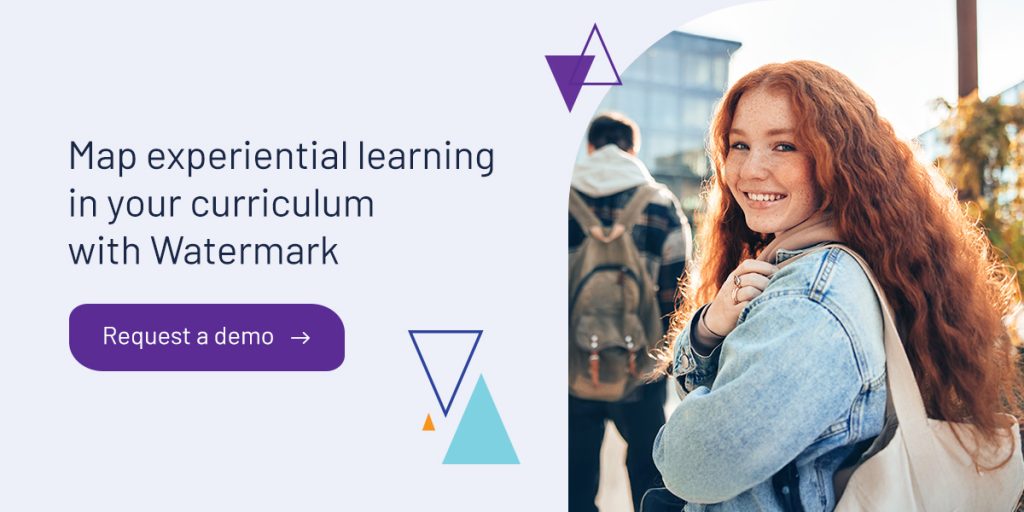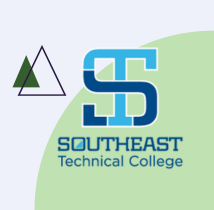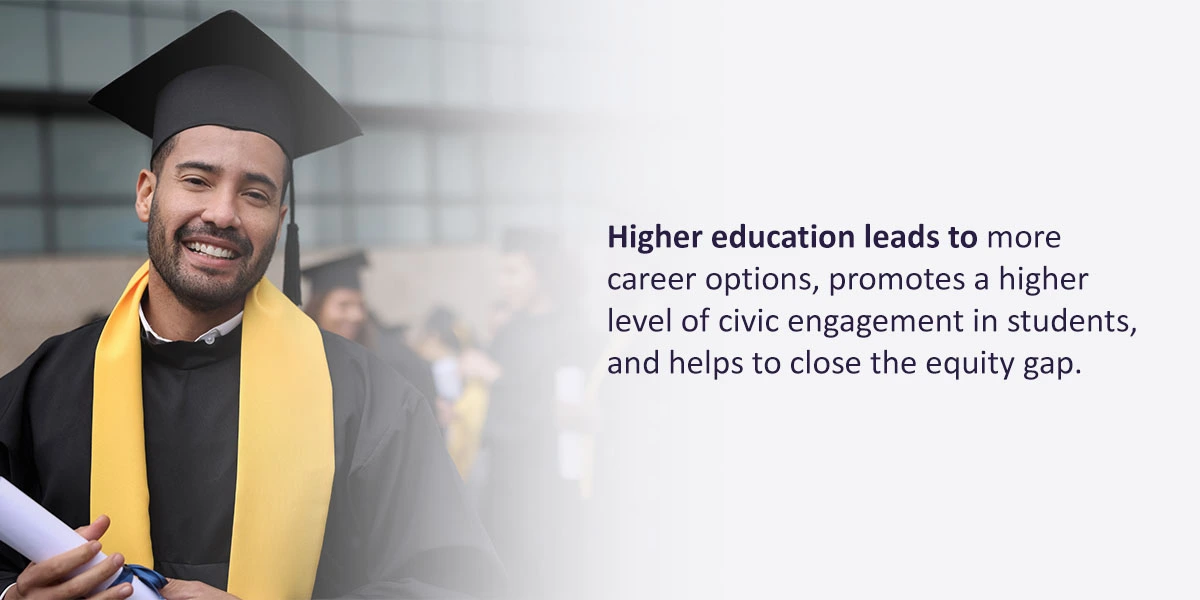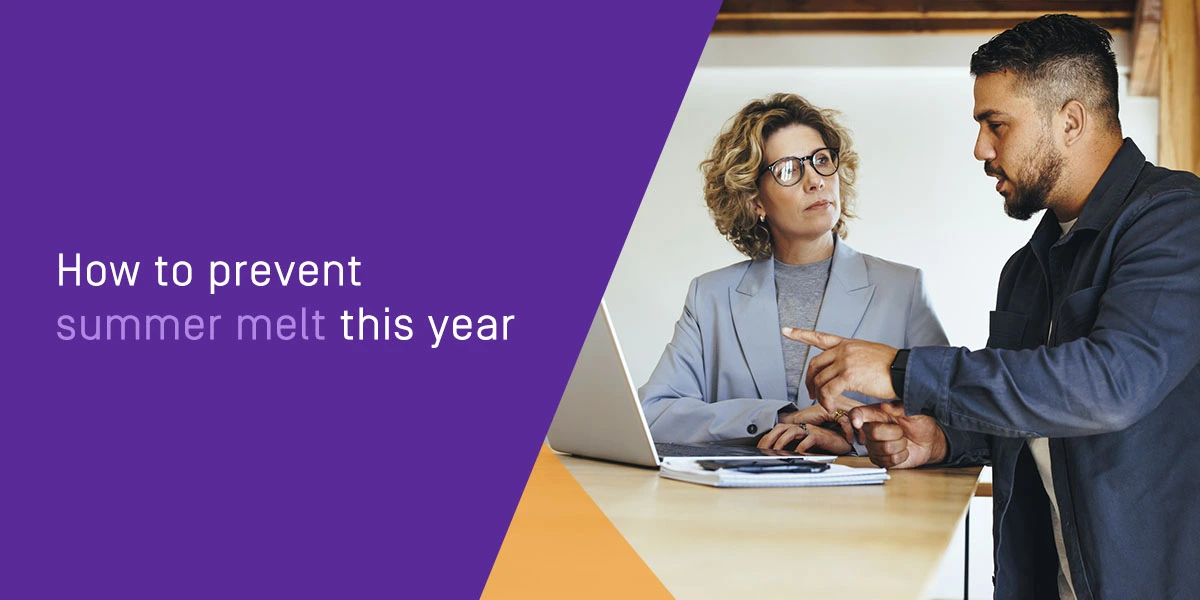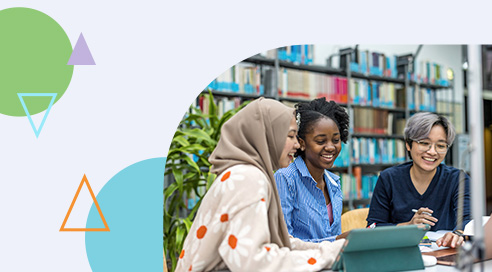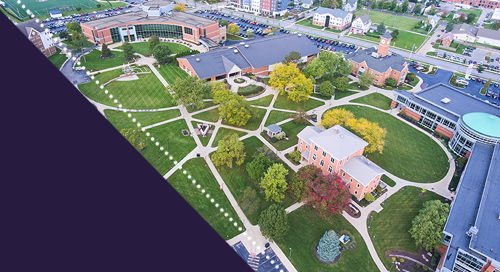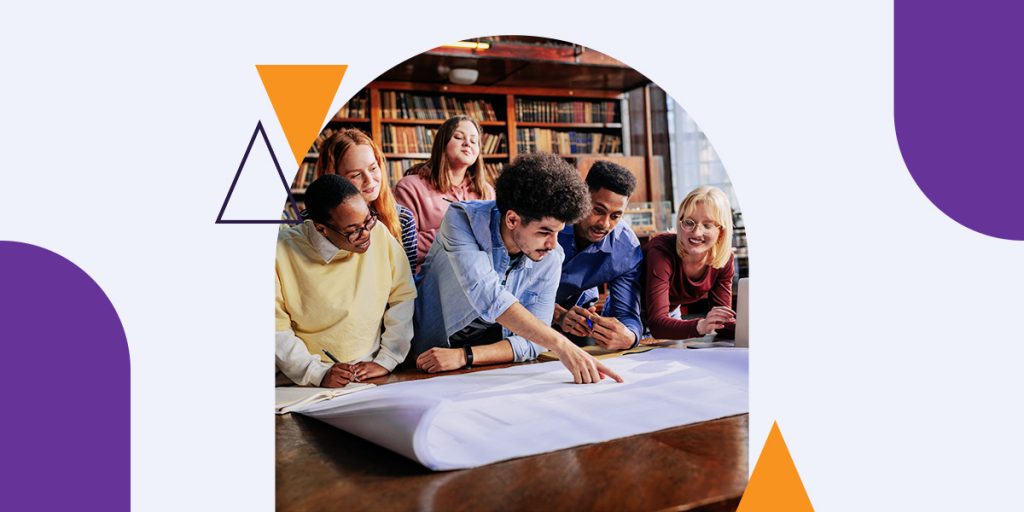
The workplace is changing at an unprecedented pace. Higher education institutions are implementing high-impact practices to ensure student learning prepares them for the workplace. Many have seen success with experiential learning, allowing students to experiment and draw meaning from the world.
Students who engage in experiential learning often have fulfilling careers, which is just one of the model’s many benefits. However, integrating experiential learning opportunities into your curriculum requires planning. In this practical guide to mapping experiential learning, you’ll learn how to derive maximum value for your students, faculty, and institution.
What is experiential learning, and why does it matter?
In simple terms, experiential learning is the process of learning by doing. It involves engaging students in hands-on experiences and connecting theories they learn in the classroom with practical applications. Experiential learning theory, developed by David A. Kolb, outlines the ideal learning process in a four-step cycle:
- Experiencing: Students use their senses and perceptions to engage in their surroundings.
- Reflecting: At the end of a learning experience, students reflect on the process and connect their feelings with ideas.
- Thinking: Students think through the experience, forming concepts, theories, and principles they can test.
- Acting: Students test their theories and apply what they learned to gather feedback and lay the foundation for the next experience.
This experiential learning cycle mirrors the natural learning we experience in many situations. It offers several benefits, including:
- Increasing engagement: Experiential learning makes education more relevant and interactive, enhancing each student’s intrinsic motivation and engagement with the course material.
- Enhancing soft skills: Creating an experiential learning environment for your students enhances a range of skills, including critical thinking, problem-solving, collaboration, communication, and self-regulation.
- Improving employability: Many experiential learning opportunities occur in professional environments, allowing students to learn in-demand skills that benefit their future careers.
- Boosting confidence: Experiential learning allows students to participate actively in their education. It gives them a safe space to make mistakes, allowing them to build confidence in their skills.
How curriculum mapping supports experiential learning

Curriculum mapping establishes the link between course content and expected student learning outcomes. It involves aligning teaching activities, learning goals, and assessment methods with desired educational objectives. It creates a more integrated and coherent curriculum and guides faculty to ensure that courses stay on track with student outcomes. Curriculum mapping also helps you create educational programs that meet the experiential learning outcomes that students need to succeed.
Some of the many ways curriculum mapping supports experiential learning include:
Identifying and sequencing student competencies
Curriculum mapping helps you identify the core competencies and learning outcomes that each student should achieve. You can define competencies based on the desired skills and abilities necessary for success in experiential learning. One skill builds on the other, ensuring a logical and sequential progression of competencies. Students can build on their abilities progressively, mastering the basics before moving on to the next learning stage.
Integrating and aligning experiential learning with institutional objectives
A curriculum map ensures that experiential learning doesn’t happen in a vacuum. Instead of being incidental, it’s aligned with academic standards, accreditation requirements, and industry expectations. It solidifies the connection between theoretical learning and practical application while ensuring that every element of your curriculum works as a cohesive whole.
Finding gaps, overlaps, and improvement opportunities
When you can see your entire curriculum mapped out, it’s easier to identify improvement opportunities. You can see where students aren’t learning what they need from experiential opportunities and pinpoint areas where you can add more. Experiential learning is only meaningful if it relates to overarching learning outcomes. With curriculum mapping, you can ensure that every activity contributes to long-term student goals, making every experience more meaningful for students.
Simplifying Assessment and Evaluation
Although experiential learning is a process of trial and error, you still need a way to assess whether students meet the desired outcomes. Curriculum mapping streamlines the alignment of assessments and evaluations with the identified competencies. It helps ensure that your chosen assessment measures each student’s practical skill mastery. You can track and evaluate student progress, allowing students to draw their own conclusions and providing personalized feedback and support for improvement.
Promoting transparency, collaboration, and continuous improvement
With the right tools, your institution can complete curriculum mapping digitally. Faculty members who use curriculum mapping solutions in the same department can access each other’s plans. They communicate to ensure that students leave their classes with similar theoretical and practical knowledge. Faculty can also collaborate across departments to ensure students receive a holistic education.
Students and faculty know what to expect so they can use and allocate resources effectively, identify redundancies, and address gaps in the learning experience. A curriculum map also provides data and insights into the effectiveness of experiential learning, allowing you to analyze student assessment and performance data to identify areas for improvement. It’s an iterative process that ensures your experiential learning programs remain responsive to changing student and workforce needs.
How to map experiential learning at your institution
Creating an experiential learning curriculum requires a specialized approach. It requires faculty to give students more responsibility and autonomy over their learning. It also requires you to allocate resources and foster partnerships with local businesses and communities to provide students with meaningful experiential opportunities.
An experiential learning curriculum map is a comprehensive plan that supports students and faculty on the route to course completion. These maps help students explore majors and reflect on the career-relevant skills they gain, get hands-on job preparation, and engage in relevant job preparation.
Some of the steps you can take to create an experiential learning curriculum include:
Identify existing experiential learning opportunities
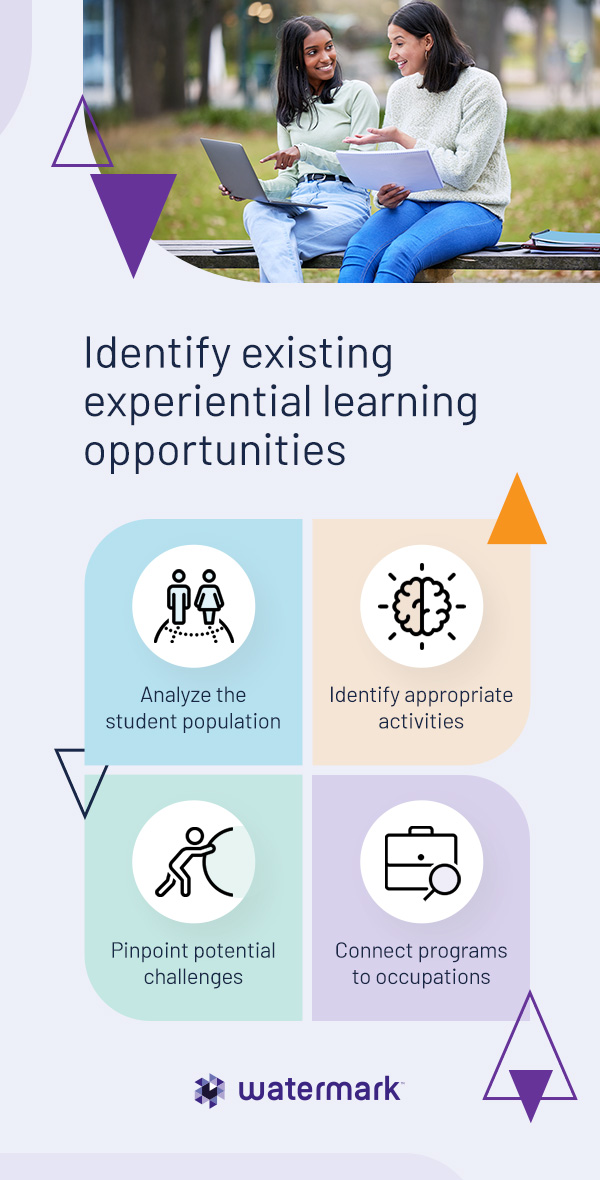
The first step in mapping experiential learning to outcomes is to identify the most meaningful experiences for students. As you begin the planning process, there are several steps you can take to identify experiential learning opportunities:
- Analyze the student population: Experiential learning opportunities depend on the student, course, and department. Look at your target student group and consider their needs. Look beyond their current level of mastery and identify where you can enrich the learning experience.
- Identify appropriate activities: Faculty must consider the existing course content experiential learning could enhance. Then, they must link the activity with course objectives in a way that drives the whole curriculum forward.
- Pinpoint potential challenges: Once you have identified appropriate activities, the next step is to look for challenges, such as developing partnerships and handling liability.
- Connect programs to occupations: Students want to see the connection between their learning and careers. Create experiences around career-focused topics so that they can see the value in their learning.
Depending on your resources and course content, you can integrate any of the following experiential learning opportunities:
- Apprenticeships: These structured programs provide on-the-job training, allowing students to earn money and network with potential employers.
- Internships: Students can join internship programs where they can work with professionals in their intended industry and gain practical experience.
- Practicums: Practical experiences align directly with what students learn in the classroom. Students can solve real-world problems while you assess their competency in a particular area.
- Community-based learning: This experiential learning practice combines academics with community service to benefit students and their communities. They can work on projects that directly impact the community, conduct research, or raise awareness about issues that affect the local community.
- Simulation exercises: You can create simulations of real-world environments, allowing students to experiment and make mistakes while preparing for their future careers.
When choosing experiential learning opportunities, the higher the student involvement, the more ownership and empowerment you’ll see. Encourage students to respond naturally to their environments and provide feedback on the outcomes so you can continue iterating and refining your processes.
Align experiential learning with educational outcomes
Every experiential learning opportunity should lead to quantifiable student development. Before launching an experiential learning program, engaging in outcome mapping is essential. Establish learning outcomes and make them contextually relevant. Regardless of the type of experiential learning, you can create learning outcomes that cover students’ theoretical understanding, practical application, and reflection.
These experiences become more meaningful to students if you reinforce the learning with reflection and metacognition — thinking about their thoughts. Although experiential learning outcomes must be measurable, rote responses may not provide the right experience. Use a combination of written, visual, narrative, and interpersonal reflection to make learning more engaging and effective.
Some tips for aligning experiential learning with student outcomes include:
- Design for relevance: Make the coursework matter to someone besides the student. Relevant and public assignments are more meaningful to students. Public presentations and assessments reinforce the real-world applications of experiential learning and sharpen soft skills like public speaking and collaboration.
- Collaborate with faculty and staff: As pioneers of your experiential learning program, your faculty and staff must be on board. Provide training in experiential learning pedagogy and best practices, and give them the resources they need to implement these opportunities.
- Get input from industry professionals: If the goal of your experiential learning opportunity is to equip students with in-demand skills, input from industry professionals is invaluable.
- Evaluate each experiential learning opportunity: Collect student learning and development data and ask faculty and students for feedback. The more information you have on each program’s success, the better you can refine your offerings.
Map comprehensive curricula
Experiential learning works best when it integrates seamlessly into your curriculum. A comprehensive curriculum map allows you to identify gaps, meet institutional objectives, and provide students with the relevant skills. Using purpose-built software solutions, you can see all your data in one place and quickly determine how experiential learning fits into your curriculum.
Some tips for creating a comprehensive curriculum include:
- Start at the end: Determine what you want students to take away from the program and build experiential learning opportunities around that goal.
- Build a logical pathway to completion: Once you’ve defined learning objectives, you can decide on the order in which students learn. Arrange theoretical and practical topics in a way that ensures a smooth progression, allowing students to build a solid foundation in each area.
- Make objectives measurable: Set up experiential learning opportunities to provide as much data as possible. The more data you have, the more informed your decisions.
- Connect experiential learning with occupations: Students choose higher education to pursue meaningful careers. Align your experiential learning programs with experience in their desired industries and fields.
Evaluate and refine your curriculum map
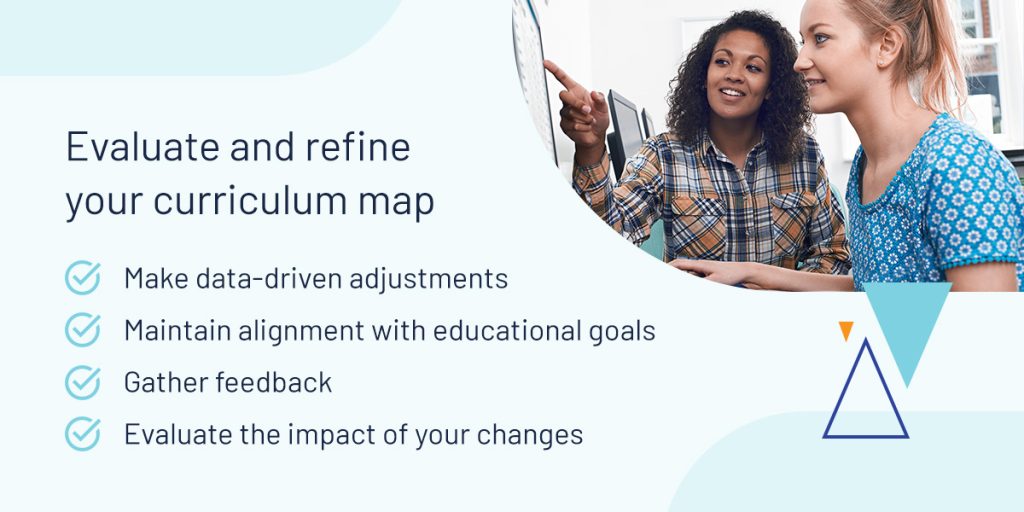
Curriculum mapping is a dynamic framework for continuous improvement that allows you to refine your course offerings in line with changing student needs. Once you have a completed curriculum map, follow these simple tips:
- Make data-driven adjustments: Assessment results, student performance, and faculty feedback give you insights into the effectiveness of your experiential learning opportunities. Your data helps identify areas where students excel and where they need more attention. You can adjust teaching strategies, content delivery, and assessment methods to address each student’s needs.
- Maintain alignment with educational goals: Educational goals continuously evolve to align with the workplace. Evaluate your experiential learning content to ensure it remains aligned with the relevant industry. You can use your curriculum map to adapt to these changes. Revisit it often to ensure that learning objectives align with shifting educational priorities.
- Gather feedback: Ask stakeholders, including students, parents, and industry experts, for feedback on your curricula and experiential learning opportunities. You can also survey students to gauge their satisfaction, engagement, understanding, and implementation of your courses.
- Evaluate the impact of your changes: You can measure the impact of your changes with assessment data. If your assessments align with your objectives, you’ll face data demonstrating how well students meet the course objectives. You can continue to tweak your experiential learning as you identify more needs and gaps in your program.
Integrating experiential learning across programs
Experiential learning is designed to give students an idea of what to expect in the workplace, which includes interdepartmental collaboration. You can embed experiential learning across disciplines, from service-learning projects in liberal arts to capstone internships in science, technology, engineering, and mathematics (STEM).
Providing students with interdisciplinary opportunities helps them develop competencies and outcomes like communication, cooperation, and cultural awareness. They must communicate with diverse audiences and encourage collaboration between disciplines, as they would in the workplace.
As the workplace changes and employers emphasize skills over theoretical knowledge, experiential learning undeniably creates a cohesive, institution-wide strategy for student success. It’s a model that benefits everyone, from students and faculty to the institution and future employers. Staying agile in the face of a changing higher education landscape means embracing experiential learning to offer future student generations more engaging, practical, and relevant learning.
Map experiential learning in your curriculum with Watermark
Mapping experiential learning into your curriculum gives students the hands-on education they need to succeed in the workplace. With the right curriculum mapping tools, you can simplify and streamline the process. Watermark Curriculum Strategy provides visual workflows to map out processes, reduces duplicate data entry, and ensures course consistency across departments.
Use student feedback to inform curricular changes and collaborate with all stakeholders to build a curriculum that drives student success. Request a demo of our solutions today!
